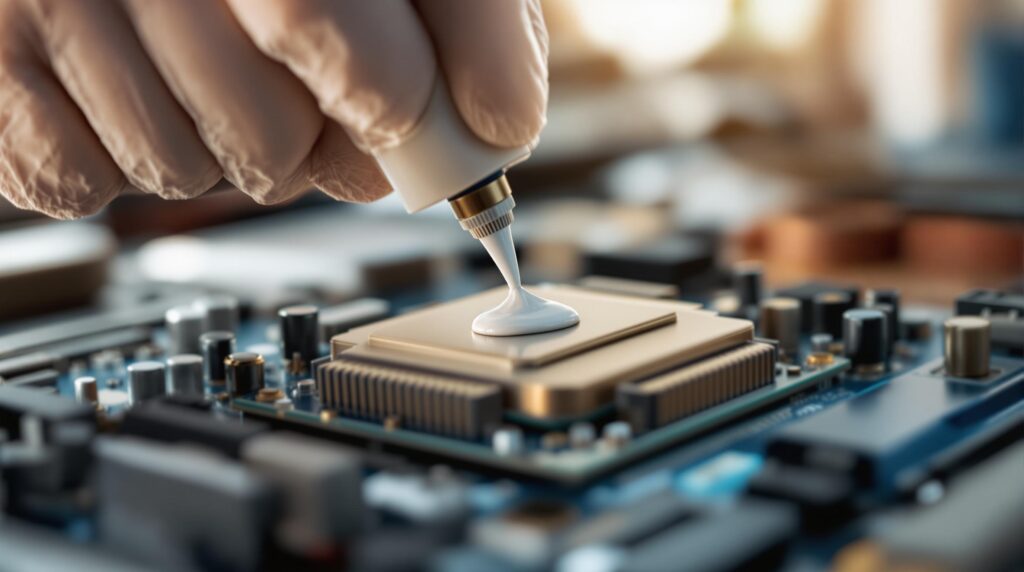Applying thermal paste to your CPU is crucial for keeping your system cool and running efficiently. Here’s a quick guide to get started:
- Why it matters: Thermal paste fills tiny gaps between the CPU and heatsink, improving heat transfer and preventing overheating.
- When to reapply: If your CPU runs hotter than usual, crashes, or you’ve replaced hardware, it’s time for a fresh application.
- Methods: Choose between the pea-size drop, single line, or manual spread methods depending on your CPU shape and preference.
- Step-by-step process: Clean the CPU, apply the paste correctly, and secure the heatsink for optimal performance.
Quick Tip: Use a pea-sized amount for most CPUs and ensure even coverage to avoid air pockets. Monitor your CPU’s temperature after installation to confirm proper heat transfer.
For detailed instructions, troubleshooting tips, and mistakes to avoid, continue reading below.
How to Apply Thermal Paste to a CPU
Getting Ready
Start by powering off your system, unplugging it, and carefully removing the heatsink to access the CPU.
Make sure you have the right tools and cleaning supplies on hand. Clean the CPU and heatsink thoroughly using an appropriate method, and let both surfaces dry completely before moving forward.
Prepare a clean, static-free, and well-lit workspace. Keep everything organized to avoid interruptions or mistakes during the process.
For professional guidance, you can consult Computer Mechanics Perth.
Once everything is clean and your workspace is set up, you’re ready to move on to selecting an application method.
Application Methods
Here’s how to apply thermal paste effectively, depending on your CPU’s shape and your preference.
Pea-Size Drop Method
Perfect for square CPUs, this method involves placing a small dot (about 4-5mm) of thermal paste in the center of the CPU. When you attach the heatsink, the pressure spreads the paste evenly across the surface.
Why it works:
- Prevents air pockets and ensures even coverage
- Limits paste from spilling over the edges
- Ideal for most desktop CPUs
Single Line Method
Best for rectangular CPUs, this method uses a thin line of paste (approximately 2mm wide) applied down the center, covering about 70% of the CPU’s length.
Tips for success:
- Apply steady, even pressure
- Keep the line straight and centered
- Avoid using too much paste
- Leave a small gap at the edges to prevent overflow
Manual Spread Method
This method involves spreading the paste manually with a spreader to cover the entire CPU surface.
| Advantages | Drawbacks |
|---|---|
| Full control over coverage | Increased chance of air bubbles |
| Ensures even distribution | Takes more time |
| Precise application | Requires additional tools |
| Works well for larger CPUs | Risk of uneven layers |
How to do it right:
- Start with a small amount in the center
- Use light, even pressure to spread outward
- Aim for an ultra-thin layer, just enough to faintly see the CPU surface beneath
- Avoid going over the same area multiple times
The goal is simple: cover the CPU completely with as little excess paste as possible. A thin, even layer ensures optimal heat transfer. Pick the method that suits you best, and check out the next section for a step-by-step application guide.
sbb-itb-078dd21
Step-by-Step Guide
Paste Application Steps
- Clean and prepare the CPU surface
- Use 90% (or higher) isopropyl alcohol to remove old thermal paste.
- Wipe the surface with a lint-free cloth until it’s completely clean.
- Allow the surface to dry fully, which usually takes 2–3 minutes.
- Check the thermal paste
- Make sure the paste hasn’t separated or dried out.
- Stir gently to mix it if separation has occurred, but avoid introducing air bubbles.
- Work at room temperature (68–77°F or 20–25°C) for best results.
- Apply the paste
- Hold the syringe perpendicular to the CPU surface.
- Use your preferred method (pea-size drop, single line, or manual spread) to apply the paste.
- Apply steady, even pressure to ensure the paste spreads evenly.
Once the paste is applied, you’re ready to install the heatsink.
Heatsink Installation
- Position the heatsink
- Place the heatsink directly above the CPU.
- Keep it parallel to the CPU for proper alignment.
A properly positioned heatsink ensures effective heat transfer.
- Mount the heatsink
- Tighten the screws in a cross-pattern, starting with opposite corners.
- Turn each screw gradually (2–3 turns per corner) to maintain balanced pressure.
- Secure the mounting
- Double-check that all mounts are engaged and the heatsink is firmly secured.
Installation Check
After mounting the heatsink, perform these checks to ensure everything is set up correctly:
| Check Point | What to Look For | Action if Issue Detected |
|---|---|---|
| Visual Inspection | No thermal paste overflow | Carefully clean any excess paste |
| Heatsink Movement | No wobble or looseness | Retighten the mounting screws |
| Mounting Pressure | Even contact across the CPU | Reinstall if pressure is uneven |
| Cable Management | No obstruction to fan motion | Adjust cable routing as needed |
Final verification steps:
- Start your system and monitor the CPU temperatures.
- Let the system idle for 10–15 minutes, checking for temperatures around 85–95°F (29–35°C).
- Run a load test for 15–20 minutes to confirm temperatures stay below 176°F (80°C).
If temperature issues persist, consider reaching out to Computer Mechanics Perth. Their technicians can help ensure your CPU is installed correctly and running efficiently.
Mistakes to Avoid
Before completing your installation, watch out for these common issues that can impact your CPU’s cooling performance.
Amount of Paste
Applying the right amount of thermal paste is crucial for effective cooling. Using too much can act as an insulator, trapping heat and even risking damage to nearby components. On the other hand, using too little can leave air gaps between the CPU and heatsink, leading to poor heat transfer and potential overheating.
For most processors, a pea-sized drop in the center of the CPU is sufficient. Larger, high-performance CPUs might need slightly more.
Surface Cleaning
Cleaning the surfaces properly is key to ensuring good thermal conductivity. Skipping this step can result in:
- Leftover residue reducing thermal conductivity
- Poor contact between the CPU and heatsink
- Uneven heat transfer across the surfaces
Make sure to remove oils, debris, and old paste completely, and let any cleaning solution fully evaporate before applying new paste.
Old Paste Problems
Using old or degraded thermal paste can hurt your cooling system’s efficiency. Common issues include:
- Paste separating over time, reducing effectiveness
- Hardened paste potentially damaging the CPU during removal
- Air pockets forming as paste dries out, leading to poor heat transfer
Thermal paste typically lasts about two years under normal conditions. If your CPU temperatures are higher than usual, it might be time to reapply. For assistance, consider consulting experts like Computer Mechanics Perth to keep your cooling system in top shape.
Avoid these mistakes to maintain your CPU’s cooling performance and prevent unnecessary overheating.
Wrap-Up
Now that your CPU cooling system is installed, let’s recap the important steps and actions to keep it running efficiently.
Key Points to Remember
- Thermal Paste Application: Apply a pea-sized amount of thermal paste and ensure both the CPU and heatsink are completely clean. This prevents air pockets and ensures proper heat transfer.
Keep an Eye on Temperatures
Use reliable software to monitor your CPU’s temperature. If you notice unusual spikes, double-check your installation and consider reapplying the thermal paste.
When to Call for Help
Still having issues? Reach out to Computer Mechanics Perth for professional assistance. Their team can correctly apply thermal paste, check heatsink installation, fine-tune your cooling setup, and perform hardware diagnostics. Contact them at (08) 9325 1196 or visit their website for more details.
FAQs
1. How to Apply Thermal Paste to your CPU?
To apply thermal paste to your CPU:
- First, clean the CPU and cooler with isopropyl alcohol and a lint-free cloth.
- Apply a small pea-sized dot (about 4–5mm) of thermal paste to the center of the CPU’s integrated heat spreader (IHS).
- Install the cooler evenly, pressing down gently to spread the paste.
- Ensure the layer is thin and even, covering the surface evenly for better heat transfer.
- Tighten the cooler screws in a cross pattern for balanced pressure.
2. Why Do You Need Thermal Paste?
Thermal paste fills microscopic gaps between the CPU and the cooler, enabling efficient heat transfer. This approach improves heat transfer, reduces CPU temperatures, and prevents overheating. Without it, the CPU cannot dissipate heat effectively, leading to poor cooling performance and possible thermal throttling or hardware damage.
3. How much thermal paste for a CPU?
You only need a pea-sized or rice-grain amount of thermal paste roughly 4–5mm in diameter, depending on your CPU size. Applying too much thermal paste can cause overflow and damage components, while too little leads to air gaps and poor heat conduction.
4. Should you squish or spread thermal paste?
It is best to let the CPU cooler’s pressure spread the thermal paste naturally, as manually spreading can trap air bubbles or create uneven layers. When the cooler is installed with even pressure, the paste spreads perfectly between the surfaces for maximum thermal conductivity.
5. What is a mistake when applying thermal paste?
Common mistakes when applying thermal paste includes:
- Using too much or too little paste.
- Not cleaning the CPU or cooler surface before applying.
- Touching the paste or spreading it unevenly.
- Reusing old thermal paste instead of fresh application.
6. Do you have to apply thermal paste on a CPU?
Yes, applying thermal paste is essential unless your cooler comes with pre-applied paste. It ensures optimal heat transfer from the CPU to the cooler, maintaining safe operating temperatures and extending CPU longevity.

